To mark International Women’s Day and acclaim the struggles and triumphs of Irish women since the foundation 50 years ago of the National Women’s Council, we’ve curated A History of Irish Women in 50 Objects. Yes, well spotted, we’re objectifying Irish women but in an illuminating, celebratory way.
From communion dresses to repeal merch, pungent carbolic soap to banned books, and the medieval Sheela na Gig to a top-of-the-range vibrator, these 50 objects tell just part of the colourful story of Irish women through the last several decades. What object would you include on the list? We’d love to read your suggestions – you can submit them using the form at the end of this article.
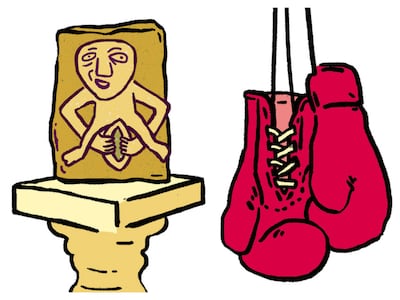
1. Sheela na Gig: Found all over Europe, Ireland has by far the highest concentration of these exhibitionist medieval carvings which feature women’s genitalia. It’s not known for sure whether they were fertility symbols or meant to ward off evil spirits. Either way, they scream Big Vulva Energy.
2. Dear Frankie letter: “Welcome to Women’s Page, a programme for and about you” is how Frankie Byrne opened her radio show Dear Frankie, which ran from 1963 until 1985. Hailed on her death as a “national institution” by Gay Byrne (no relation), she was a pioneer when it came to uncovering the struggles faced by many Irish women.
3. Boxing gloves: Between that glorious Olympic gold for Kellie Harrington and the many achievements of the undisputed world lightweight boxing champion Katie Taylor, Irish women are slaying in the boxing ring. Last year Harrington, Amy Broadhurst and Aoife O’Rourke took home three golds from the European Boxing Championship while Caitlin Fryers and Christina Desmond landed silver.
4. Crolly Doll: A beloved possession of many girls across Ireland and abroad, these dolls entered production in 1939 in Co Donegal. Named after the post-office in Crolly from where they were exported, the dolls famously wore clothing made from local tweeds, linens and wool. The dolls were produced until the 1970s and are now collectors items.
5. Maura Laverty cookbook: Well known for her novels with racy content, Laverty also wrote cookery books, , from Flour Economy to Full and Plenty. By the 1960s they were found in nearly every home in the country. Her books championed the domestic contribution of Irish women and encouraged respect for their labour.
6. Wicker cradle: A baby cradle, woven from wicker, was collected on Inis Óirr in the 1950s and is now on show in the Museum of Country Life. Fintan O’Toole included it in his book and newspaper series A History of Ireland in 100 Objects – a brilliant format we’ve shamelessly borrowed for this list – writing “that it was made with such loving skill suggests both its necessity and its importance”.
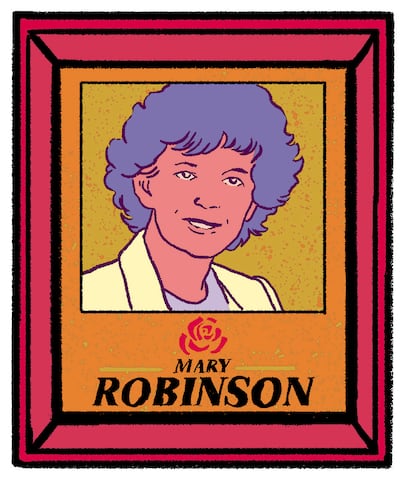
7. Mary Robinson election poster: In December 1990, senator and campaigning constitutional lawyer Mary Robinson became our first woman president. Her election marked the beginning of a more liberal era. Robinson has often told the story of a woman who, when asked by her husband for a cup of tea after Robinson’s election, replied: “Things have changed around here! Make it yourself.”
8. Film censor certificate: Of the 2,500 films banned in the State, the first film censor in Ireland, James Montgomery, was responsible for banning 1,800. He said of one film: “The girl dancing on the village green shows more leg than any girl I’ve seen dancing on an Irish village green. Better amputate them.”
9. Are You Somebody by Nuala O’Faolain: Published in the 1990s, this “accidental memoir” by the late Irish Times columnist O’Faolain became an international best-seller. Acclaimed for the author’s candid accounts of her family background and courageous life as an independent woman in conservative, Catholic Ireland, it was as shocking as it was liberating.
[ June Caldwell on Nuala O’Faolain, 'my powerful, idiosyncratic, crude friend'Opens in new window ]
10. Camogie stick: In the early 1900s, players of the women’s equivalent of hurling lined out wearing knee covering dresses and long sleeved blouses. Máire Ní Chinnéide and Cáit Ní Dhonnchadha, both prominent Irish-language enthusiasts, were instrumental in the foundation of the sport in 1903. The first All-Ireland in 1932 was won by Dublin. These days an estimated 100,000 women play the sport worldwide.
11. Countess Markievicz statue: Statues of women are rare in Ireland but this one, on Townsend Street in Dublin, celebrates the politician and revolutionary who, as minister for labour in the First Dáil, became Europe’s first cabinet minister. Markievicz famously fought in the 1916 Rising and offered memorable advice for fellow women fighters: “Dress suitably in short skirts and strong boots. Leave your jewels in the bank and buy a revolver.”
12. Article 41.1 of the Irish Constitution: “In particular, the State recognises that by her life within the home, woman gives to the State a support without which the common good cannot be achieved. The State shall, therefore, endeavour to ensure that mothers shall not be obliged by economic necessity to engage in labour to the neglect of their duties in the home.” Sigh. Is there anything to be said for another referendum?
13. Sybil Connolly gown: Welsh-born, Dublin-based Connolly, famous for dressing Elizabeth Taylor and Jackie Kennedy, was 36 years old when she launched her own couture line in 1957 championing Irish fabrics and creating exquisite, elegant gowns. On one of her first fashion trips to the US, her full-length red cape and white crochet dress was on the cover of Life Magazine, with the caption “Irish Invade Fashion World”. Deeply religious, Connolly also redesigned nun’s habits for three different Irish orders.
14. Chains or Change: This manifesto of the Irish Women’s Irish Liberation Movement was launched on The Late Late Show in 1971 with founding members including Nell McCafferty. “From birth to death the Irish State legally enforced rules that hobbled women,” wrote feminist Rosita Sweetman on the 50th anniversary. “Chains or Change was the first attempt at documenting just what that religiosity, coupled with patriarchy, had meant.”
15. Thalidomide pills: In the late 1950s, some Irish women who experienced debilitating morning sickness were prescribed these pills, under the brand name Softenon. The pills containing the sedative thalidomide caused malformation in newborn babies. Unlike in other countries, no proper recall or warning ever occurred in Ireland and it was still available up to 1964, causing catastrophic injuries. Those surviving mothers and thalidomide babies, now adults coping with worsening health challenges, are still waiting for an apology and a fair deal from the State.
16. Soccer ball: In October 2022, a record-breaking 350,000 people watched Vera Pauw’s Irish women’s soccer team qualify for the World Cup, which takes place in Australia and New Zealand this summer. The win came five years after a media conference where players called for better conditions, saying they were “fifth-class citizens” forced to share tracksuits with underage teams and change in airport toilets.
17 Spare Rib magazine: This iconic UK-based feminist magazine had a tiny readership in Ireland before it was banned by the Censorship of Publications Board in 1977 for being “obscene”. Feminists from Irish Women United campaigned to overturn the ban, buying copies in Northern Ireland and selling them at a mass meeting in the Mansion House. Spare Rib was to have a big influence on Irish magazines and newspapers including this one, as journalist Susan Knight wrote in The Irish Press: “If nothing else Spare Rib has raised consciousness obliquely. Women’s magazines, and women’s pages for that matter, will never be quite the same again. Among the knitting patterns of your glossy you are now likely to find feminist issues discussed.”
18. Carbolic soap: For decades young women variously described as “fallen” or “wicked”, condemned for the “sins” of being raped or engaging in consensual sexual activity, were incarcerated in Catholic-run, State-endorsed Magdalene laundries. Subjected to cruel treatment and forced labour, some women escaped, some were released and others remained institutionalised, ending their days there as elderly women. Survivors have reported that the pinky-red Carbolic soap was the underlying, pervading odour. In Anu’s acclaimed theatre production Laundry in 2012, every audience member got a bar to take home as a pungent sensory reminder.
19. A Woman’s Heart: Released in 1992, A Woman’s Heart was a compilation album featuring seven Irish women artists: Eleanor McEvoy, Mary Black, Dolores Keane, Sharon Shannon, Frances Black, Maura O’Connell and Sharon Shannon. It sold more than 750,000 copies in Ireland that year with the title track by McEvoy getting extensive radio play. Altogether now: “My heart is low, my heart is so low, as only a woman’s heart can be.”
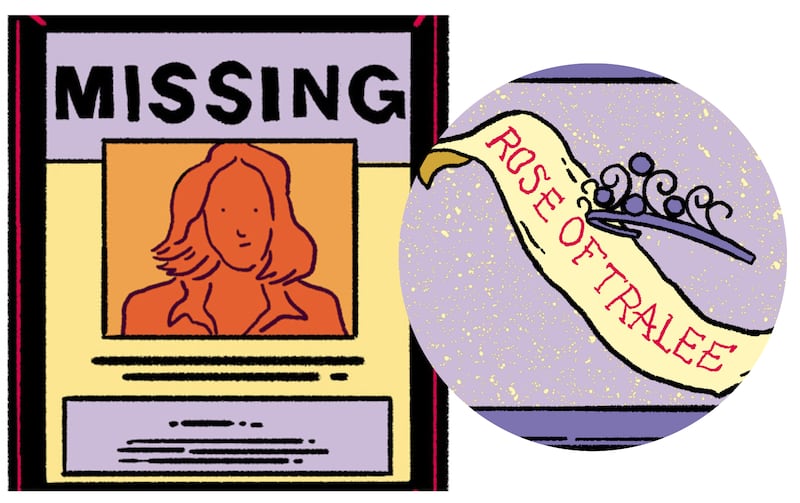
20. Missing woman poster: Fiona Pender. Jo Jo Dullard. Deirdre Jacob. Ciara Breen. The names of Ireland’s many missing women are intermittently raised in newspapers and current affairs programmes. Also missed by their families and friends are the hundreds of victims of femicide, killed in Ireland through acts of violence perpetrated by men, often partners or ex partners. Since 1996, Women’s Aid’s Stolen Lives project has been tracking the stories of these victims of male violence against women.
21. Rose of Tralee crown: Lampooned in Father Ted as a Lovely Girls contest, the Rose of Tralee continues to garner huge television audiences and has managed to move with the changed, more inclusive times. Married women, once barred, are now permitted to enter. Transgender women are also eligible; the new rule states entrants must be “female or identify as female”.
22. Vibrator: Imelda May wrote a poem – GBH or Grievous Battery Harm – eulogising these instruments of self-pleasure while the pandemic heralded a huge rise in the sale of sex toys in this country. Shawna Scott, the self-confessed “smut peddler in chief” for online store Sex Siopa, says her current best-seller is the Pillow Talk Sassy Rechargeable G-Spot Vibrator. It, er, comes in pink or blue.
[ Imelda May: ‘Sex can be more fun as you get older and you care less’Opens in new window ]
23. Lace: Made for the richest women in Europe, the finest Irish lacework was often produced by some of the poorest women and girls in Ireland. Production is thought to have begun in the 1730s, providing a way for young Irish women to support their families, in some cases saving them from starvation. Highly skilled and delicate work, lace-making schools sprang up around the country, producing distinctive work known by geographic location such as Limerick, Carrickmacross, Youghal, Borris, Kenmare or Clones lace. Carrickmacross lace featured on the wedding veils of both Princess Diana and Kate Middleton.
24. ESB ad: Encouraging women to go electric with all manner of new appliances, a popular 1930s ad for the Electricity Supply Board featured a suspiciously unharried-looking Irish housewife. The image and copy were almost certainly dreamt up by a man: “The house fragrantly clean. The laundered things crisp and snowy. The food easily and perfectly cooked. The mistress of the home free from unnecessary toil ... free to rest and read and recapture that sense of buoyant joy in life which comes from congenial work and compensating ease.”
25. Tampons: While not as visible in media reports, several women were involved in the “Dirty Protests” that occurred in some Northern Ireland prisons in the late 1970s and early 1980s in response to the treatment of Irish prisoners by British prison guards. One key difference with the women’s protest was the menstrual blood smeared by the women on cell walls. As Niamh McClelland of the online Women’s Museum of Ireland wrote: “When menstrual blood became visible, so too did the genuine participation, determination and passion of the Republican women ... individuals imprisoned while fighting for their country at the expense of their freedom and dignity.”

26. Virgin Mary statue: Paula Meehan’s powerful poem, The Statue of the Virgin at Granard Speaks, was published in The Irish Times in 1984 in memory of 15-year-old Co Longford schoolgirl Ann Lovett who died giving birth to her son, who also died, at a grotto in her hometown. Meehan imagined the statue witnessing and commentating on the deaths: “... and she lay down alone at my feet/without midwife or doctor or friend to hold her hand/and she pushed her secret out into the night/far from the town tucked up in little scandals.”
27. Peig by Peig Sayers: “I am an old woman now, with one foot in the grave and the other on its edge,” is the memorable opening line of a book maligned by many of us at school. In fairness to Peig, a skilled seanchaí of the Great Blasket Islands, she has had something of a renaissance in recent years with her own exhibition at the Museum of Modern Literature Ireland. Her Irish language books offer a rare insight into the life of an Irish woman and her family in a remote part of the country at the turn of the 19th century.
28. Bicycle: As a mode of transport, the bicycle was a game-changer for women, especially in rural Ireland in the 1940s and 1950s. The National Museum of Ireland has collected cycling memories from people, including this one from Geraldine Sylver-O’Malley of Louisburg, Co Mayo, whose mother Angela O’Shaughnessy cycled from Craughwell to Galway City for shopping. “Distance was no problem, neither were the winding roads to Tubber and Kilfenora, Co Clare for céili and craic ... she actually met her future husband whilst cycling to a funeral – he noticed her as she flew past him. She was quite a speedy one! She finally parked her bicycle in 2006 aged 92 having covered many milestones during her decades.”

International Women’s Day: Celebrating 50 years of Irish Feminism
29. Speculum: This instrument, used by healthcare providers to hold open the vagina, is included here to represent the appalling CervicalCheck cancer scandal that claimed the lives of women such as Vicky Phelan. It also represents the many women who have had a raw deal in the Irish healthcare system: from unnecessary womb removals to delayed endometriosis diagnoses, from symphysiotomies to poor menopause treatment, from transvaginal mesh devices to a lack of access, until recently, for abortions. With the establishment in 2019 of the government’s Women’s Health Taskforce aimed at improving women’s health outcomes and experiences, we can only hope the times are changing.
30. Mama Shee’s Kilishi: One of the many benefits of our population becoming more diverse in recent years is entrepreneurial women introducing new ideas and flavours to this country. Food company Mama Shee was created by Edizemi Onilenla, who is bringing the rich taste of Nigerian cuisine to the Irish food industry. Kilishi is a type of spicy beef jerky.
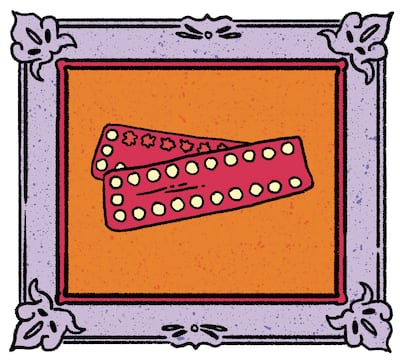
31. The pill: In 1971, protesting against the State’s Catholic church-influenced prohibition of the contraceptive pill, members of the Irish Women’s Liberation Movement took the train to Belfast to procure contraband. They ended up with condoms, spermicidal jelly and a load of aspirin figuring the customs people wouldn’t know the difference between it and the actual pill. As an awareness-raising publicity stunt, it was exemplary. Two years later, Mary McGee won her case against the State with the Supreme Court ruling there was a constitutional right to marital privacy which allowed for the use of contraceptives.
32. Dr Lydia Foy’s birth certificate: After a 22-year battle involving three court cases, transgender woman Dr Lydia Foy became the first person to be legally recognised by the Gender Recognition Act, which was passed on July 15th, 2015. “With this piece of paper and after 22 years of struggle, my country has finally recognised me for who I really am, not for what other people think I should be,” she said of her newly amended birth cert.
33. Communion dress: Even as many have abandoned Catholicism, the tradition of First Communion is still strong, possibly because of sentimentality, or the opportunity for a party, complete with bouncy castle. The white frock for girls is part of the package, even if some are unsettled by its child-bride connotations and emphasis on female purity and chastity.
34. The Country Girls by Edna O’Brien: Published in 1960, O’Brien’s first novel was banned in Ireland for its frank depictions of women’s sexuality. Dubbed “indecent and obscene” by the censor, it was still widely read and has never been out of print. Anne Enright once wrote: “Edna O’Brien’s erstwhile neighbours might have burned copies of The Country Girls in the churchyard... up in Dublin everyone who was a reader read it without a qualm.”
35. Pro-life badge. These anti-abortion badges recall the campaign to insert the 8th amendment into our Constitution in 1983. Abortion was illegal, but the amendment sought to copper-fasten that by equating the right to life of an adult woman with that of her unborn child. It was supported by the Pro-Life Amendment Campaign, Fianna Fáil, some of Fine Gael, the Catholic hierarchy and many lay Catholics. On September 7th, 1983, 67 per cent of those who voted endorsed the Amendment.
36. Sinéad O’Connor’s Pope picture: O’Connor was vilified for tearing up a picture of Pope John Paul II on Saturday Night Live in 1992 in a fierce stand against paedophilia in the Catholic Church. “Fight the real enemy,” she shouted after tearing the photo into pieces. Global and Irish condemnation followed – Frank Sinatra said he wanted to kick her ass – but O’Connor was proved right about the widespread child abuse in the church and the protest inspired young women activists around the world. Kathryn Ferguson, director of the recent O’Connor documentary Nothing Compares, called the singer “one of the boldest, bravest Irish women that’s ever lived”.

37. St Brigid’s cross: Move over Patrick. Brigid, finally, is having her moment with a national bank holiday named for this legend which was enjoyed for the first time this year. Some call her a goddess, others a saint, but either way this ancient mythological woman is associated with the cross made from rushes that people still make on February 1st, and hang above their doors to ward off evil.
38. Irish dancing costume: Testament to how culture continually morphs, these dresses have become more elaborate, more expensive and ever further away from the Irish jewellery, textiles and calligraphy that inspired early 20th-century costumes. Half a century ago girls already wore costumes with embroidered Celtic motifs and ringleted hair. These days wildly expensive frocks are often accessorised by improbably enormous wigs and the ubiquitous fake tan.
39. Stand Up, Speak Out by Monica McWilliams: A Catholic from south Belfast, McWilliams was the academic and peace activist who cofounded the Northern Ireland Women’s Coalition. A political party with a feminist platform, the party had a vision of peace based on inclusion, human rights and equality. McWilliams’ memoir recalls the inside story of a woman at the centre of the Northern Ireland peace talks.
40. Wedding ring: Once you had a ring on it, you were out the door. The marriage bar forced women to resign civil or public service (and often private sector too) jobs after marriage, and disqualified married women from applying. The law reflected social attitudes: a husband’s duty was to support his wife, whose place was in the home. It denied generations of women a career, independence and pension rights, and was only lifted in Ireland in 1973. Meanwhile, Criminal Conversation, a law stating that a wife was the property of her husband and which was abolished in England in 1857, remained on Irish statute books until 1981.
41. Unmarried Mothers Allowance book: In 1975 campaigners celebrated this weekly allowance, which came to just more than eight old Irish pounds. It was the first social welfare payment to acknowledge the existence of women bringing up children on their own. Although mother and baby homes were still operating the 1990s, the allowance also marked the beginning of the end for those Catholic-run institutions that caused lifelong trauma for so many Irish mothers and their babies.
42. Repeal jumper: Galvanised by the death of Savita Halappanvar in 2015, Wicklow woman Anna Cosgrave designed these strikingly simple jumpers which would became a potent symbol in the fight for the reproductive rights of women and girls in Ireland. Created in support of the Abortion Rights Campaign, they featured one word – Repeal – printed in white capital letters on a black sweatshirt. Images of women wearing the jumpers featured in newspapers around the world when, in June, 2018, the country voted by a landslide to repeal the 8th amendment, lifting the near-total ban on abortion.
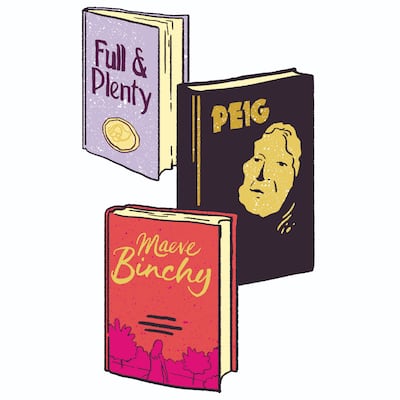
43. Maeve Binchy novel: There’s probably a book by the late fiction-writer and Irish Times journalist in most Irish homes. A hugely popular writer, her work was strong, comforting, familiar and characterful, but also opened up rarely-spoken-of realities of repressed lives. There’s a clear throughline from her work to hugely successful contemporary writers, from Marian Keyes to Sally Rooney.
44. NWC soapbox: The soapbox, like all suffragette soapboxes before it, has supported women to tell their truths, win their freedoms and uphold their rights. From this soapbox – at rallies, on marches, and outside the Dáil – the women of Ireland helped to profoundly change the face of our country.
45. Sindy Joyce’s doctorate: In 2019, Dr Sindy Joyce became the first Traveller in Ireland to be awarded a doctorate for her PhD thesis, Mincéirs Siúladh: An ethnographic study of young Travellers’ experiences of racism in an Irish city. The thesis explored how anti-Traveller racism shapes young people’s use of urban spaces. Currently on staff at the University of Limerick, Dr Joyce is also the first Traveller to be appointed as a full-time lecturer in an Irish university and a member of President Michael D Higgins’ Council of State.
46. Grace O’Malley statue: This 7ft 4in statue of pirate queen Gráinne Mhaol was unveiled by Dr TK Whitaker in 2003 on the grounds of Westport House, Co Mayo. “She was an extraordinary woman,” he said, “deploying intellect, charm and even force at times to get her there; one hand firmly on the tiller, the other ready to draw her sword.”
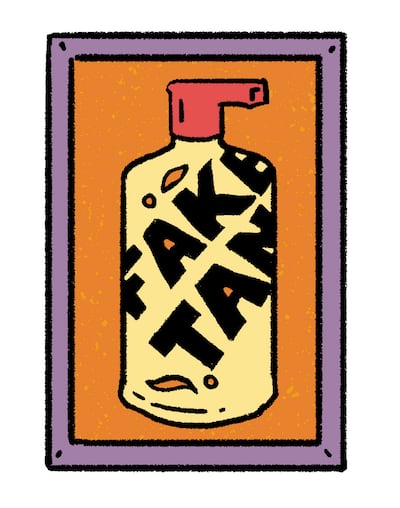
47. Fake tan: With so many young and not-so-young Irish women not content to endure their naturally pale, milk-bottle-adjacent complexions, fake tan has done a roaring trade in Ireland for years. And we make it well too. Launched in 2012, Marissa Carter’s Cocoa Brown is now sold in 23 countries worldwide with a bottle of the stuff selling every four minutes.
48. Rosie Hackett Bridge: By far the largest object on our list, the Rosie Hackett Bridge is the only one on the river Liffey named after a woman. And what a woman. Dubliner, trade unionist, nationalist and worker’s rights activist, Hackett was one of the women who went on strike at Jacob’s biscuit factory during the Lockout of 1913, losing her job as a result. It was while working in Liberty Hall, near where her bridge stands, that she cofounded the Irish Women’s Worker’s Union and became connected to the Irish Citizen Army (ICA). During the 1916 Rising, she was on duty at the first-aid unit of the ICA at St Stephen’s Green.
49. Mantilla: For a long time, no mass-going woman in Ireland would be seen without this lace head covering. The veil was apparently a sign of a woman’s desire to humble herself before God. Few women wear mantillas now, but the female faithful in Ireland and elsewhere are still excluded from positions of leadership in their church.
50. Brenda Fricker’s Oscar: This may change soon enough – fingers crossed for Kerry Condon – but at the time of writing Brenda Fricker is the only Irish woman to have been awarded an Oscar for an acting role. In 1989 Fricker won Best Actress in a Supporting Role for her portrayal of Christy Brown’s mother in My Left Foot. “I’d like to thank Mrs Brown,” she said in her acceptance speech. “Anybody who gives birth 22 times deserves one of these.”
The list was compiled by Róisín Ingle with help from Deirdre Falvey, Patrick Freyne, Jennifer O’Connell, Catriona Crowe, Anthea McTeirnan, The Little Museum of Dublin and the National Women’s Council.
The Women’s Podcast is celebrating 50 years of the National Women’s Council in a special live recording for International Women’s Day this Wednesday, March 8th. Listen at irishtimes.com/womenspodcast













